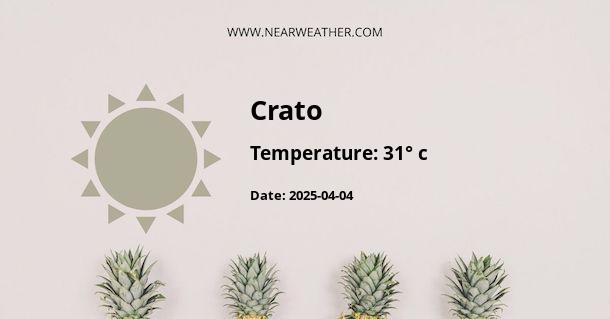Weather and Climate in Crato, Brazil
Crato is a city located in the northeastern region of Brazil. It is known for its rich history, vibrant culture, and unique climate. Understanding the weather patterns and climate of Crato is essential for residents, tourists, and businesses operating in the region. Let's take an in-depth look at the climate and weather conditions in Crato throughout the year.
Climate Overview
Crato experiences a tropical savanna climate, also known as Aw according to the Köppen-Geiger classification. This type of climate is characterized by a dry season and a rainy season, with consistently high temperatures throughout the year. The city is located in the semi-arid region of Brazil, which significantly influences its climate patterns.
Temperature
The average annual temperature in Crato is around 25°C (77°F). The city experiences minimal temperature variations throughout the year, with average highs of 31-33°C (88-91°F) and average lows of 18-22°C (64-72°F). The hottest months are typically from September to November, with temperatures occasionally surpassing 35°C (95°F).
Rainfall
Crato has a distinct wet season and dry season. The rainy season spans from January to July, with the peak rainfall occurring from February to May. During this period, the city receives the majority of its annual precipitation. The dry season, from August to December, is characterized by minimal rainfall and arid conditions.
The average annual rainfall in Crato is approximately 800mm (31 inches). The variability in precipitation can have significant impacts on agriculture and water resources in the region.
Humidity
Due to its semi-arid climate, Crato experiences relatively low humidity levels, particularly during the dry season. Humidity levels typically range from 50% to 70% during the wet season and may drop below 30% during the dry season. The low humidity can contribute to an increased risk of wildfires and drought conditions.
Wind Patterns
The wind patterns in Crato are influenced by its proximity to the equator and the surrounding topography. During the dry season, prevailing winds from the northeast contribute to arid conditions and can result in dust storms. In contrast, the wet season brings variable winds with increased moisture content from the Atlantic Ocean, contributing to the region's rainfall.
Extreme Weather Events
Crato, like many regions in northeastern Brazil, is susceptible to extreme weather events, including droughts, flooding, and occasional tropical cyclones. These events can have significant social, economic, and environmental impacts on the city and its surroundings. Effective disaster preparedness and climate resilience measures are essential for mitigating the impacts of these events.
Best Time to Visit
For travelers looking to visit Crato, the ideal time is during the cooler and drier months from August to December. During this period, the weather is more comfortable for outdoor activities and exploration. However, it's important to note that natural attractions may be less vibrant during the dry season due to reduced vegetation and water flow in rivers and waterfalls.
Conclusion
In conclusion, Crato's climate is characterized by its tropical savanna climate with distinct wet and dry seasons. Understanding the weather and climate patterns is crucial for residents, businesses, and tourists to plan and prepare for the varying conditions throughout the year. With its unique climatic features, Crato continues to be a captivating destination for those seeking to experience the diverse natural environment of northeastern Brazil.
A - Crato's Latitude is -7.234170 & Longitude is -39.409439.
A - Weather in Crato is 29° today.
A - Climate Conditions in Crato shows scattered clouds today.
A - Humidity in Crato is 51% today.
A - Wind speed in Crato is 0 km/h. today.
